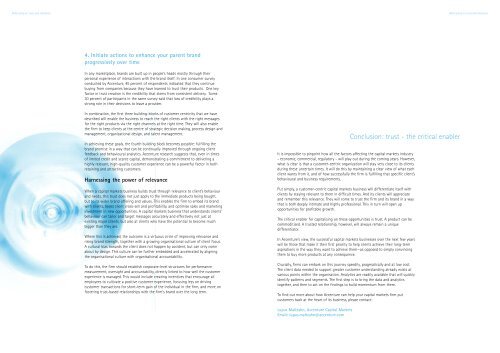Central brochure
Central brochure
Central brochure
You also want an ePaper? Increase the reach of your titles
YUMPU automatically turns print PDFs into web optimized ePapers that Google loves.
Refocusing on trust and relevance Refocusing on trust and relevance<br />
Creating the client-centric capital markets<br />
business of the future<br />
Four key building-blocks<br />
Accenture has helped a number of leading capital markets firms to reshape and<br />
revitalise their client relationships. Our approach draws on our deep experience in<br />
building and optimising customer relationship value across a wide range of<br />
industries, while taking account of the unique characteristics, competitive dynamics<br />
and opportunities inherent to the capital markets industry.<br />
Based on this experience, we have defined an approach that is both pragmatic and<br />
effective. Getting customer centricity off the ground does not require a large upfront<br />
investment. Instead, a firm can make real and substantial progress by extracting<br />
its existing client data, and applying relevant, targeted analytics quickly and at low<br />
cost. The momentum behind the resulting ongoing improvement in client<br />
relationships and profitability can then be built up progressively over time.<br />
Our experience shows that four key steps can enable a capital markets firm to begin<br />
the journey towards putting clients back at the heart of its business.<br />
The four steps are:<br />
1 Conduct basic analytics to understand clients’ needs and buying behaviours<br />
2 Group clients into segments reflecting behaviour and need<br />
3 Realign your product offering and delivery channels to support client needs<br />
and profitability<br />
4 Initiate actions to enhance your parent brand progressively over time<br />
A firm that focuses successfully on all four of these areas will find it can build<br />
deeper, more durable and more profitable client relationships based on mutual trust<br />
and value.<br />
1. Conduct basic analytics to understand clients’<br />
buying needs<br />
Building better and deeper client understanding may sound like a good idea in<br />
theory. But how can it be achieved in practice? Many capital markets businesses<br />
assume the answer must be a major multi-year, multi-million pound CRM investment<br />
programme that transforms and integrates the management and analysis of client<br />
data across the business. However, our experience shows that a more pragmatic and<br />
phased approach — requiring far less up-front investment — actually has a far<br />
greater chance of success.<br />
In many cases, efforts to impose a customer-centric culture from top-down through<br />
a massive systems implementation project fail because of three challenges. The first<br />
is the siloed structure of much of the legacy IT infrastructure, with different business<br />
units unable to share information easily or effectively. The second is issues around<br />
data protection and client privacy, again preventing sharing of data. The third is that<br />
embedded ‘fiefdoms’ in the business may be unwilling to share client information<br />
and relationships that they feel belong to them individually, rather than to the firm<br />
as a whole. These same barriers have the effect of impeding cross-selling and an allround<br />
view of client profitability.<br />
Starting small: a pragmatic approach to analytics<br />
Given these issues, a ‘large’ systems implementation effort is usually not the best<br />
way forward, and will struggle to deliver. Client data may exist at many points across<br />
the business, in many formats. A more workable and effective solution may be to pull<br />
together these disparate elements of data into one place, and then conduct analytics<br />
to identify and understand the patterns in clients’ behaviours and needs.<br />
In industries where companies have hundreds of thousands or even millions of<br />
clients, this approach would be impracticable. But capital markets businesses benefit<br />
from having relatively small numbers of relatively large clients, rather than a<br />
multitude of small ones. And a comparatively limited amount of effort in pulling<br />
together the required data can produce dramatic results, enabling the firm to create<br />
hypotheses around how to improve the offering to each client, or at least clusters of<br />
similar clients.<br />
Launching a small initial pilot programme of client data analytics also brings several<br />
additional benefits. By kick-starting deeper client understanding, it can help to<br />
highlight not just patterns of client behaviour, but also the most pertinent elements<br />
of data that will help to clarify and illuminate those patterns. As more and better<br />
data is pulled in, the analytics can be iterated to progressively sharpen the insights.<br />
And the early findings can be leveraged to produce ‘quick wins’ that deliver good<br />
returns in a short timeframe, helping to sell the idea of analytics-based segmentation<br />
to the sales team and across the business as a whole.<br />
Compounding the benefits<br />
Once the iterative analytics programme is embedded and gaining momentum, the<br />
insights generated can be incorporated into the firm’s management information and<br />
incentives going forward, thus facilitating the cultural shift required. One approach<br />
for extending and embedding the programme is to build simple software that collects<br />
and analyses the client data firm various sources — thereby replicating many of the<br />
benefits of rebuilding the CRM infrastructure, but at a far lower cost and much<br />
higher speed.<br />
In the longer term, the benefits of better client understanding will be felt throughout<br />
the organisation. By providing senior management with insights into why customers<br />
buy particular product and service offerings, it enables the business to regain control<br />
of client understanding and insight from the fiefdoms. Furthermore, unifying the<br />
client data across products and sales teams enables individual client profitability to<br />
be tracked, managed and improved. And if regulators ask why a particular product<br />
was sold to a particular client, robust information is available to show why the<br />
product purchase was in line with the client’s needs and behaviour.

















